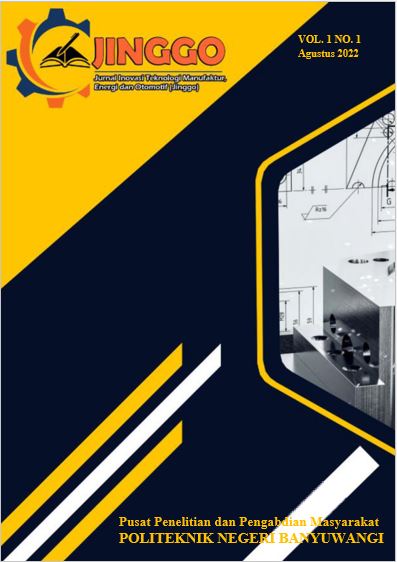STUDI PENGARUH VARIASI KOMPOSISI BIORESIN EPOKSI- MINYAK KELAPA SAWIT UNTUK APLIKASI CORE SANDWICH MATERIAL LAMBUNG KAPAL
DOI:
https://doi.org/10.57203/jinggo.v1i1.2022.11-20Abstract
Vegetable oil is biodegradable, non-toxic, environmentally friendly, and renewable so that it becomes an alternative to replace mineral oil and chemicals. This research will develop a bioresin which is a mixture of epoxy with natural polymer such as palm oil. The homogenization method uses a hot plate so that the mixing reaches miscible materials. The results of bioresin testing with variations in the composition of palm oil showed that the optimal composition variation was E-MS (10%) because it had a low tensile strength value of 53.111Mpa. While the highest elongation value is 14.04767%, and has a low hardness value of 86.3 on the shore D scale. The highest density value is 1.25254(g/cm3). Judging from the standard L'loyd Register and BKI (Indonesian Classification Agency) that the values of all tensile strength test results meet the standards and all variations in the composition of the test results and elongation values meet the minimum criteria.
References
Anthony L. Andrady, et all. “Applications and Societal Benefits of Plastics.”, Philos T R Soc B, 2019, 364:1977-84.
Chaoqun Zhang, et all. “Recent Advances in Vegetable Oil-Based Polymers and Their Composites.”, Progres in Polymer Science , Volume 71, 2017, Pages 91-143.
Pascualt, et all. “Epoxy Polymers, New Materials and Innovations.”, Wiley-VCH Verlag GmbH & Co. KgaA, Weinhei, 2010.
Eli, dkk,. ”Studi Pengaruh Jenis Minyak Nabati terhadap Campuran Bioresin Vinil ester-Minyak Nabati.”, Seminar Nasional Teknologi Industri Berkelanjutan I (SENASTITAN I) Surabaya, 6 Maret 2021.
Callister, et all. “Materials Science and Engineering.”, An Introduction 8th Edition, 2007.
Ray, et all. “Biocomposites for High-Performance Applications.”, Biocomposites for High-Performance Applications, 2017, 57-58.
I.Choedkiatsakul, K.Ngaosuwan, G.Cravotto, S.Assabumrungrat. “Biodiesel Production from Palm Oil Using Combined Mechanical Stirred and Ultrasonic Reactor.”, Ultrasonics Sonochemistry , Volume 21, Issue 4, 2014, Pages 1585-1591.
Kamila Mizera,et all. “Polyurethane Elastomers from Polyols Based on Soybean Oil with a Different Molar Ratio.”, Polymer Degradation and Stability, Polymer Degradation and Stability, Volume 132, 2016, Pages 21-31.
Bimlesh Lochab, I. K. Varma, J. Bijwe. “Sustainable Polymers Derived from Naturally Occurring Materials.”, Advances in Materials Physics and Chemistry, 2012, 221-225.
Catia Costa, Ana C.Fonseca, JorgeMoniz, MariaGodinho, Armenio C.Serra, Jorge F.J.Coelho. “Soybean and Coconut Oil Based Unsaturated Polyester Resins.”, Thermomechanical Characterization, Industrial Crops and Products Volume 85, 2016, Pages 403-411.
Alejandrina Campanella, Eduardo Rustoy, Alicia Baldessari, Miguel A.Baltanas. “Lubricants from chemically modified vegetable oils.”, Bioresource Technology, Volume 101, Issue 1, 2010, Pages 245-254.
Rondang, T. “Teknologi Oleokimia.”, Departemen Teknik Kimia Fakultas Teknik Universitas Sumatera Utara, 2006, 168.
Rostami, S.“Polymer Blends:Structure and Properties.”, Encyclopedia of Materials: Science and Technology, 2018, 7202–7206
Sulistijono. “Mekanika Material Komposit”, ITS Press, 2012.
Edy Utomo, Achmad Zubaydi, Pompy Pratisna. “Study of Core Material Sandwich Panel in Ship Construction.”, The 2nd International Seminar on Science and Technology, (hal. 93-98), 2016, Surabaya.
Lloyd’s Register. “Provisional Rules for the Application of Sandwich Panel Construction to Ship Structure.”, 2015, Jerman.
Badan Klasifikasi Indonesia. “Rules for the Classification and Construction.”, Part.1 : Seagoing Ships, 2014, Indonesia.
ISO 527. “Plastic-Determination of Tensile Properties.”, First Edition, Part 4, International Organization for Standardization (ISO), 1997, Switzerland.
ASTM D570. “Standard Test Method for Water Absorption of Plastics.” ,American Society for Testing and Materials (ASTM) ,Philadelphia, USA.
Rohman. "Application of FTIR Spectroscopy for The Determination of Virgin Coconut Oil in Binary Mixtures with Olive Oil and Palm Oil.". Journal Am Oil Chem Soc, Vol 87, 2010, pages 601-606.
Ardhyananta, et all. "Mechanical and Thermal Properties of Unsaturated Polyester/Vinyl Ester Blends Cured at Room Temperature". Materials Science and Engineering, Vol 202, 2017, Pages 1-8.
Czub. “Application of modified natural oils as reactive diluents for epoxy resins.”, Macromol Symp, 2006, pp. 60-64.
Bahr, et all. “Linseed and soybean oil-based polyurethanes prepared via the non-isocyanate route and catalytic carbon dioxide.”, conversion Green Chem, 2012, pp. 483-489.
Chand, et all. “Abrasive wear studies on maleic anhydride modified polypropylene and polyethylene terephthalate blends.”, Regional Research Laboratory (Council of Scientific and Industrial Research), 2006, Bhopal, India.
Daramola, ett all. "Water Absorption Characteristic of Epoxy Matrix Composites Reinfroced with Green Silica Particles.". Journal of Practices and Technologies, Issue 32,2018, pages 215-232.
Downloads
Published
Issue
Section
License
Authors who publish with this journal agree to the following terms:
- Authors retain copyright and grant the journal right of first publication with the work simultaneously licensed under a Creative Commons Attribution License that allows others to share the work with an acknowledgement of the work's authorship and initial publication in this journal.
- Authors are able to enter into separate, additional contractual arrangements for the non-exclusive distribution of the journal's published version of the work (e.g., post it to an institutional repository or publish it in a book), with an acknowledgement of its initial publication in this journal.
- Authors are permitted and encouraged to post their work online (e.g., in institutional repositories or on their website) prior to and during the submission process, as it can lead to productive exchanges, as well as earlier and greater citation of published work (See The Effect of Open Access).







